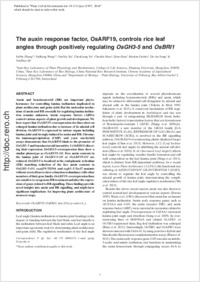The auxin response factor, OsARF19, controls rice leaf angles through positively regulating OsGH3-5 and OsBRI1
- Zhang, Saina State Key Laboratory of Plant Physiology and Biochemistry, College of Life Sciences, Zhejiang University, Hangzhou, China
- Wang, Suikang State Key Laboratory of Plant Physiology and Biochemistry, College of Life Sciences, Zhejiang University, Hangzhou, China
- Xu, Yanxia State Key Laboratory of Plant Physiology and Biochemistry, College of Life Sciences, Zhejiang University, Hangzhou, China
- Yu, Chenliang State Key Laboratory of Plant Physiology and Biochemistry, College of Life Sciences, Zhejiang University, Hangzhou, China
- Shen, Chenjia State Key Laboratory of Plant Physiology and Biochemistry, College of Life Sciences, Zhejiang University, Hangzhou, China
- Qian, Qian State Key Laboratory of Rice Biology, China National Rice Research Institute, Chinese Academy of Agricultural Sciences, Hangzhou, China
- Geisler, Markus Department of Biology – Plant Biology, University of Fribourg, Switzerland
- Jiang, De An State Key Laboratory of Plant Physiology and Biochemistry, College of Life Sciences, Zhejiang University, Hangzhou, China
- Qi, Yanhua State Key Laboratory of Plant Physiology and Biochemistry, College of Life Sciences, Zhejiang University, Hangzhou, China
-
01.09.2014
Published in:
- Plant, Cell & Environment. - 2014, p. –
English
Auxin and brassinosteroid (BR) are important phytohormones for controlling lamina inclination implicated in plant architecture and grain yield. But the molecular mechanism of auxin and BR crosstalk for regulating lamina inclination remains unknown. Auxin response factors (ARFs) control various aspects of plant growth and development. We here report that OsARF19-overexpression rice lines show an enlarged lamina inclination due to increase of its adaxial cell division. OsARF19 is expressed in various organs including lamina joint and strongly induced by auxin and BR. Chromatin immunoprecipitation (ChIP) and yeast one-hybrid assays demonstrate that OsARF19 binds to the promoter of OsGH3-5 and brassinosteroid insensitive 1 (OsBRI1) directing their expression. OsGH3-5-overexpression lines show a similar phenotype as OsARF19-O1. Free auxin contents in the lamina joint of OsGH3-5-O1 or OsARF19-O1 are reduced. OsGH3-5 is localized at the endoplasmic retieulum (ER) matching reduction of the free auxin contents in OsGH3-5-O1. osarf19-TDNA and osgh3-5-Tos17 mutants without erected leaves show a function redundancy with other members of their gene family. OsARF19-overexpression lines are sensitive to exogenous BR treatment and alter the expressions of genes related to BR signalling. These findings provide novel insights into auxin and BR signalling, and might have significant implications for improving plant architecture of monocot crops.
- Faculty
- Faculté des sciences et de médecine
- Department
- Département de Biologie
- Language
-
- English
- Classification
- Biological sciences
- License
-
License undefined
- Identifiers
-
- RERO DOC 211353
- DOI 10.1111/pce.12397
- Persistent URL
- https://folia.unifr.ch/unifr/documents/303755
Other files
Statistics
Document views: 179
File downloads:
- pdf: 501
- Supplementary material: 208

